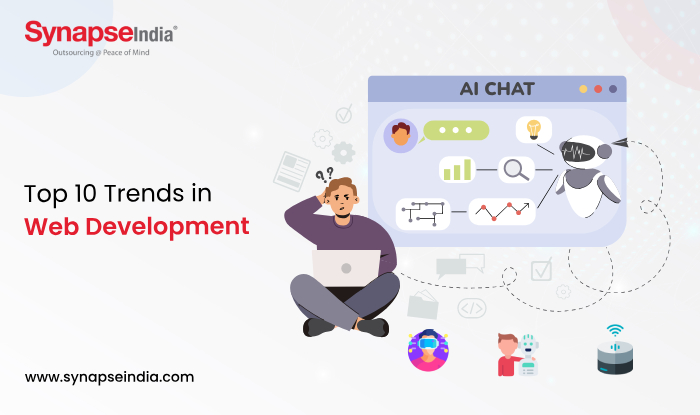 02 Apr 2024
02 Apr 2024“Stay up-to-date on the top 10 web app development trends for the best user experience. From PWAs to Jamstack, here is a list of top web development trends in 2024.”

Online presence is crucial in the digital age, here web development stands as a cornerstone to interconnect the world. From the beginnings of static web pages to the dynamic and immersive experiences of today's web applications, the journey of web development has been nothing short of transformative. Web development refers to the process of creating websites or web applications that are accessible via the Internet. It involves a combination of programming, design, and content creation to produce a functional and visually appealing online presence. Web development can range from simple static web pages to complex web-based applications. We will explore major trends in the landscape of web development and look at its fundamental concepts and emerging trends.
Web application development services refer to the designing, development, and maintenance of software applications that run on web servers. However, the most intriguing fact about web applications is that they can be accessed through web browsers. In this highly competitive market, it has become increasingly important to prioritize responsive design, ensuring functionality across devices and browsers. This is where web app development services can help. A professional development service can build custom web apps for businesses that can help enhance customer engagement, streamline operations, and expand market reach. Businesses and individuals looking to create feature-rich, user-friendly, and scalable web-based solutions can leverage these services to drive digital transformation and deliver value to end-users.
The general web app development services include steps like requirement analysis, UI/UX design, front-end and back-end development, testing, deployment, and ongoing maintenance. E-commerce platforms for online shopping, content management systems (CMS) for easy content updates, or customer relationship management (CRM) tools for managing customer interactions are some popular types of web applications that can bring wonders for any business.

To choose the right web application development company, consider factors like expertise in relevant technologies, portfolio of past projects, client reviews, and experience with similar projects. Evaluate their communication skills, project management approach, and cost-effectiveness, and also make sure they offer ongoing support and scalable solutions for future growth.
Here are the top 10 trends in web app development that we should look for :
Progressive Web Apps (PWAs) combine the greatest features of mobile and web applications. They have become increasingly popular in recent years. PWAs blur the boundaries between web and native apps with quick load speeds, offline capabilities, and device installation capabilities. PWAs offer a smooth user experience on various devices and in various network scenarios thanks to technologies like web app manifests and service workers.
SPA are known to load just one HTML page and dynamically update content as users navigate, single-page applications (SPAs) have completely changed how online applications are developed. When comparing SPAs to traditional multi-page applications, SPAs offer faster speed, seamless transitions, and a more responsive user experience. The popularity of this trend is being driven by popular JavaScript frameworks like React, Angular, and Vue.js, which enable developers to easily design complex SPAs.
The emergence of serverless architecture has revolutionized web development by freeing developers from the burden of managing servers and infrastructure, allowing them to concentrate on developing code. Developers may create scalable, reasonably priced apps that scale on demand by utilizing serverless technologies such as AWS Lambda, Google Cloud Functions, and Azure Functions. Serverless architecture facilitates smooth integration with cloud services, expedites development, and lowers operational overhead.
Although responsive design has long been a mainstay of web development, it is now growing into responsive design 2.0 due to the wide range of devices and screen sizes. The next iteration places a strong emphasis on adaptability, flexibility, and a mobile-first strategy to guarantee the best possible user experiences on all platforms. Websites may dynamically change their style and information according to the device, resolution, and orientation of the user thanks to techniques like media queries, flexible pictures, and fluid grids.
Web applications are increasingly using machine learning and artificial intelligence to provide personalized experiences, automate processes, and improve user engagement. Artificial Intelligence-driven services, such as chatbots, virtual assistants, recommendation engines, and predictive analytics, are revolutionizing user experience on websites. Developers can now use AI and ML algorithms directly in the browser thanks to frameworks like TensorFlow.js and packages like Brain.js, creating new opportunities for intelligent web applications.
The simplicity, speed, and scalability of the Jamstack design have made it popular for use in the development of contemporary online applications. Developers can create safe and quick websites and web apps by using pre-built Markup, JavaScript frameworks, and APIs, and by separating the frontend from the backend. By encouraging a modular and composable approach to web development, Jamstack empowers teams to produce outstanding user experiences, deploy confidently, and iterate rapidly.

Web developers now need to take voice search optimization into account because voice-enabled devices, such as virtual assistants and smart speakers, are becoming more and more common. Developers can increase discoverability and user engagement by optimizing website content for voice search queries, applying schema markup, and improving accessibility features. Natural language processing (NLP) methods and voice user interfaces (VUIs) enable websites to converse with users in real-time, creating new possibilities for voice-driven experiences.
Web developers now prioritise cybersecurity and privacy above everything else, as cyber dangers continue to adapt. Safeguarding user information and upholding confidence necessitates the use of best practices, such as HTTPS encryption, secure authentication methods, and data security safeguards. To reduce risks and guard against vulnerabilities, compliance with laws like the CCPA and GDPR is important. Proactive security practices like code reviews and penetration testing also help.
Platforms for low-code and no-code development are enabling people and organizations to build online applications without requiring a deep understanding of programming. These platforms facilitate the development process and shorten time-to-market by providing visual interfaces, drag-and-drop capability, and pre-built components. Although low-code/no-code solutions offer accessibility and flexibility, developers should be aware of their limitations on performance, scalability, and customization.
Blockchain technology is upending several industries, and when it is included in web development, it opens up new avenues for decentralization, security, and transparency. Developers can create distributed ledgers, smart contracts, and immutable data storage in decentralized apps (dApps) by utilizing blockchain platforms such as Ethereum and Hyperledger. Blockchain integration is changing the landscape of web development, from safe transactions and digital identity management to decentralized finance (DeFi) and non-fungible tokens (NFTs).
Web applications serve as powerful tools to manage processes, deliver services, and connect with audiences seamlessly across devices. It can help improve customer engagement, operational efficiency, and brand credibility. In addition to this, they can also help businesses enhance their global reach and accessibility and can also help make data-driven decisions. Let us explore the importance of web app development for modern businesses in a little detail.
The right tools and technologies form the backbone of creating efficient, scalable, and user-friendly applications. Check out some major tools and technologies for web application development that facilitate seamless collaboration and high performance.
Front-End Development
Back-End Development
Databases
APIs and Integration
Version Control and Deployment
Cloud platform
Testing and Debugging
Developing web applications can be a little challenging, especially with its complex requirements and security concerns. However, web development challenges can be tackled smoothly with the right mix of strategic planning, skilled teams, and advanced tools. Some prominent Web Application Development challenges include:
Complex Requirements
Evolving requirements from the web application can be a little complicated to turn into functional features which can further lead to development delays. However, clear communication and proper documentation can help overcome this issue.
Cross-Platform Compatibility
Ensuring seamless functionality across various devices, operating systems, and browsers demands rigorous testing and optimization, especially for responsive designs.
Performance Optimization
As web applications scale, ensuring fast load times and responsiveness under high user traffic becomes challenging. Efficient coding, optimizing databases, etc. are the keys to tackling these challenges.
Security Concerns
Protecting sensitive data from cyber threats requires robust security measures and regular updates which normally is a little complex. However, the right web application development services can handle this with ease.
Project Management
Meeting deadlines, staying within budget, and managing team coordination are some ongoing challenges that occur throughout the development lifecycle.
The web application development process includes:
The cost of developing a custom web application varies depending on complexity, features, design, and development hours. Small applications cost less, while enterprise-level solutions with advanced functionality and integrations are more expensive. Factors like team expertise and post-launch maintenance also influence the final cost.
Building a web application typically takes 3 to 12 months, depending on complexity, features, and team size. Simple applications may take a few weeks, while advanced solutions with custom designs, integrations, and extensive testing require more time.
The leading web development trends show the direction of innovation and advancement in the field. Developers can impact the future of the web, drive digital transformation, and create immersive experiences by embracing these trends and experimenting with new technologies. In the always-changing field of web development, there are countless options to choose from, like adopting decentralized technology, utilizing AI-powered features, and optimizing for mobile devices.


